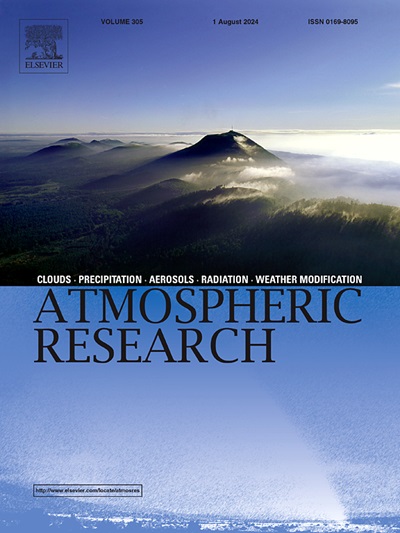The potential relationship between urban background pollution and urban-rural differences of biomass burning aerosol radiative effects in the North China Plain
IF 4.4
2区 地球科学
Q1 METEOROLOGY & ATMOSPHERIC SCIENCES
引用次数: 0
Abstract
Accurate quantitative assessment of biomass burning (BB) aerosol radiative effects (BBARE) in the North China Plain is a key scientific issue in regional aerosol radiative effects research. However, there is currently a lack of comparative analysis between BBARE based on observation and model simulations of BBARE, especially with regard to the differences between the two BBARE estimates in urban-rural differences. This study focuses on 10 typical BB events that affected Beijing during July, September and October 2014 in the North China Plain, and quantifies the BBARE at various radiation stations using both observational data-based machine learning approach and the WRF-Chem model. Based on the quantitative results, the BBARE obtained through the two methods was analysed in direct comparison and in terms of urban-rural differences. Direct comparison results indicate that the BBARE simulated by WRF-Chem shows an overall underestimation compared to the results based on observations. In terms of urban-rural differences in BBARE, observation-based BBARE was on average 91.28 % lower in urban stations than in rural stations, while model-simulated BBARE showed the opposite urban-rural difference (the urban stations' BBARE was on average 38.52 % higher than rural stations). This urban-rural difference in BBARE based on observations is due to the fact that urban SSR is more severely affected by background aerosols, resulting in limited changes in SSR caused by additional BB aerosols. However, the model simulation only considers the reduction in SSR caused by increased BB aerosols, neglecting the influence of pre-existing aerosol. By identifying these disparities, this study will help to enhance the accuracy of model simulations of BBARE.
华北平原城市背景污染与生物质燃烧气溶胶辐射效应城乡差异的潜在关系
华北平原生物质燃烧气溶胶辐射效应的准确定量评估是区域气溶胶辐射效应研究的关键科学问题。然而,目前缺乏基于观测的BBARE与模型模拟BBARE的对比分析,特别是两种BBARE估算的城乡差异的差异。以2014年7月、9月和10月华北平原影响北京的10次典型BB事件为研究对象,采用基于观测数据的机器学习方法和WRF-Chem模型对各辐射站的BBARE进行量化。在定量结果的基础上,对两种方法得到的BBARE进行了直接比较和城乡差异分析。直接比较结果表明,与观测结果相比,WRF-Chem模拟的BBARE总体上被低估了。在BBARE的城乡差异方面,基于观测的城市站BBARE平均比农村站低91.28%,而模型模拟的城市站BBARE平均比农村站高38.52%。基于观测的城乡BBARE差异是由于城市SSR受背景气溶胶的影响更严重,导致额外的BB气溶胶对SSR的影响有限。然而,模型模拟只考虑了BB气溶胶增加导致的SSR减少,忽略了已有气溶胶的影响。通过识别这些差异,本研究将有助于提高BBARE模式模拟的准确性。
本文章由计算机程序翻译,如有差异,请以英文原文为准。
求助全文
约1分钟内获得全文
求助全文
来源期刊

Atmospheric Research
地学-气象与大气科学
CiteScore
9.40
自引率
10.90%
发文量
460
审稿时长
47 days
期刊介绍:
The journal publishes scientific papers (research papers, review articles, letters and notes) dealing with the part of the atmosphere where meteorological events occur. Attention is given to all processes extending from the earth surface to the tropopause, but special emphasis continues to be devoted to the physics of clouds, mesoscale meteorology and air pollution, i.e. atmospheric aerosols; microphysical processes; cloud dynamics and thermodynamics; numerical simulation, climatology, climate change and weather modification.
 求助内容:
求助内容: 应助结果提醒方式:
应助结果提醒方式:


